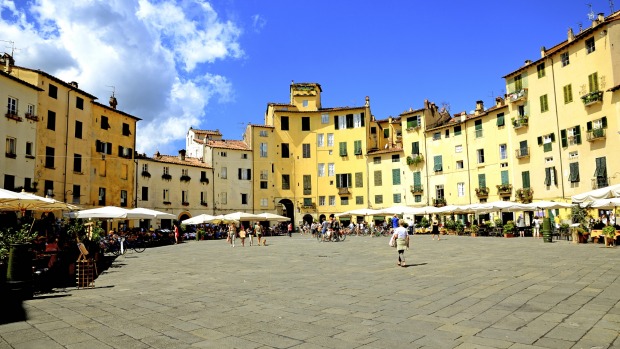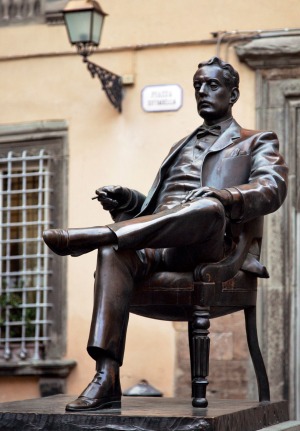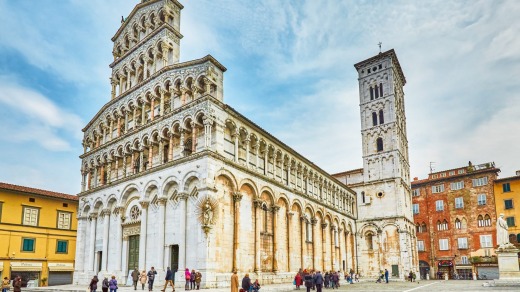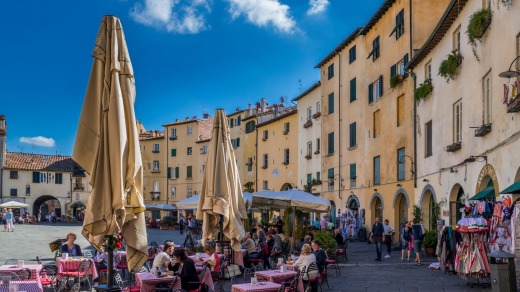
"Puccini was a notorious smoker," our chirpy guide Antonella tells us. "He smoked 80 Toscano cigars a day, which is why the statue of him outside the house where he was born shows him holding one in his right hand."
And how did one of Italy's greatest composers die?
"We don't know exactly," Antonella says. "But the people of Lucca say his grave is still smoking!"

Posters of Lucca's most famous son are dotted all over the Tuscan city, advertising different Puccini events. Those of him as a young man, with luxuriant moustache, suggest he was a dead ringer for Freddie Mercury. And, according to Antonella, he was just as promiscuous.
"Puccini adored motor cars — and had 14 of them," Antonella explains. "But as much as he loved automobiles, he loved women more."

There's an operatic pause. "Though perhaps Puccini never loved women as much as he loved Toscano cigars."
Today Lucca, which dates to Roman times and boasts a wealth of medieval and Renaissance churches, towers, piazzas and one of the best-preserved walls in Europe, likes to market itself as "the city of Puccini".
Numerous cafes and restaurants have names inspired by his works: Madame Butterfly Restaurant, Nessun Dorma Cafe. And excerpts of his compositions are regularly performed at lunchtime recitals and evening concerts.

Then, of course, there is the small museum that occupies the apartment where he was born on December 22, 1858, and where he lived until 1880, when he left Lucca to complete his studies in Milan. His birthplace was transformed into a museum in 1979, but it has been open to the public only since 2011 — painstakingly restored to how it was when the composer lived there.
Lucca, with Florence and Siena, is among the best Renaissance cities in Tuscany. Better preserved than Pisa or Livorgno, which both suffered extensive bombing during World War II, Lucca by then was a charming backwater. Yet it was sufficiently important in 56 BC to be the site of a secret meeting between Julius Caesar, Pompey the Great and Marcus Crassus. Known as the Lucca conference, the meeting between the three rivals postponed the oncoming civil war until Caesar's army crossed the Rubicon seven years later.
Lucca's Roman heritage, Antonella tells us, remains in the street pattern. The most obvious and delightful example is the oval Piazza Anfiteatro. The shape resembles a Spanish bullring, but it is actually a curved medieval terrace of houses that were built on the footings of Lucca's Roman colosseum.
This is a lovely spot to have coffee or lunch and marvel at how Lucca has reinvented itself over two millennium. As an example, Antonella explains how the marble from the colosseum was recycled to construct the neighbouring San Frediano, one of Lucca's 100 or so churches.
On this tour we venture inside two. The cathedral, Duomo di San Martino, and its bell tower were being restored when we visited. So the famous facade with 13th-century carvings by principal architect Guidetto da Como is partially obscured by scaffolding.
However, the $4 entry fee is justified by two works of art. Antonella leads us to Tintoretto's superb portrait The Last Supper. Instead of the usual perspective of Christ and the 12 disciples lined up on one side of a long table, Tintoretto has them gathered — animatedly, gesticulating, arguing — around an angled table that makes the scene appear three dimensional.
"This is the moment when Jesus has told his disciples that one of them will betray him," Antonella says. "Tomorrow he will be dead."
She also tells us the local tradition of how so-called "Holy Face" came to be one of Lucca's most prized emblems. The story goes that most of the cedarwood crucifix was carved by Nicodemus, who helped to embalm Jesus' body after the crucifixion. But Nicodemus, feeling unworthy to carve the face of Christ, fell asleep. He awoke to find the face had been carved with uncanny likeness by unseen hands. The crucifix is now housed in the cathedral.
How it got here is a miracle in itself. Apparently in the 8th century — with the Holy Land soon to be a battlefield — the crucifix was cast adrift in an unmanned boat. Somehow it ended up in land-locked Lucca. Sadly, many experts think the crucifix is a 13th-century fake.
From the cathedral we walk through Piazza Napoleon — created when the French emperor's sister Eliza became Duchess of Lucca — to the city's other great church, San Michele in Foro, so-named because it is built on the old Roman forum. Its facade, with a bewildering array of characters (including Galileo, Columbus, Napoleon and the archangel Michael), is impressive.
But no visit to Lucca is complete without a walk along at least a section of the city's four kilometre-long walls. These massive ramparts, Antonella tells us, were built to keep the city independent from the Medici family, who had taken over most of Tuscany. Once the Medicis had been consigned to history, Antonella says, "the people of Lucca had a party and planted trees on top of the wall so what had been planned as a powerful fortress became a peaceful park."
On these ancient walls before I catch the tour bus back to my Azamara cruise, I pass all walks from Puccini's colourful city: Joggers, cyclists, mothers with prams, dog walkers, lovers on park benches, old couples passing the time of day with friends. And, yes, even the occasional cigar smoker.
The closest airport to Lucca is Pisa, 36 kilometres away — or Florence, 70 kilometres away. It has a railway station with trains to both Pisa and Florence.
Azamara Journey has a 12-night Mediterranean Jewels voyage leaving Barcelona on July 21, 2016, for Venice. Ports include Livorgno (Pisa, Florence, Lucca); fares from $7179 per person, twin share. See azamaraclubcruises.com/en-au.
See also: The best way to travel between Italian cities